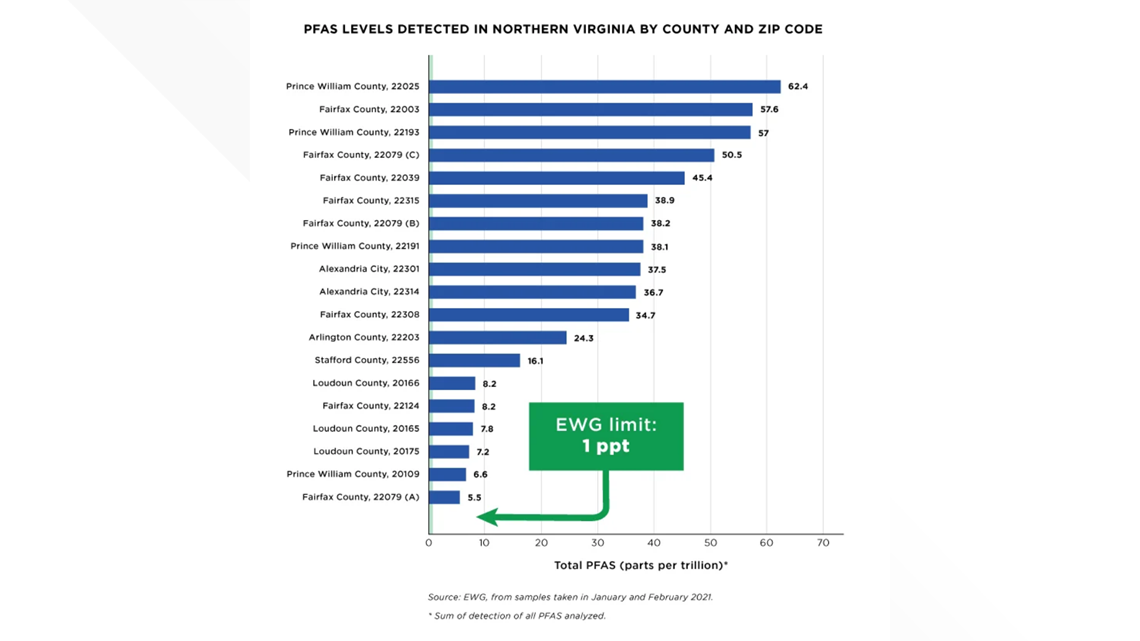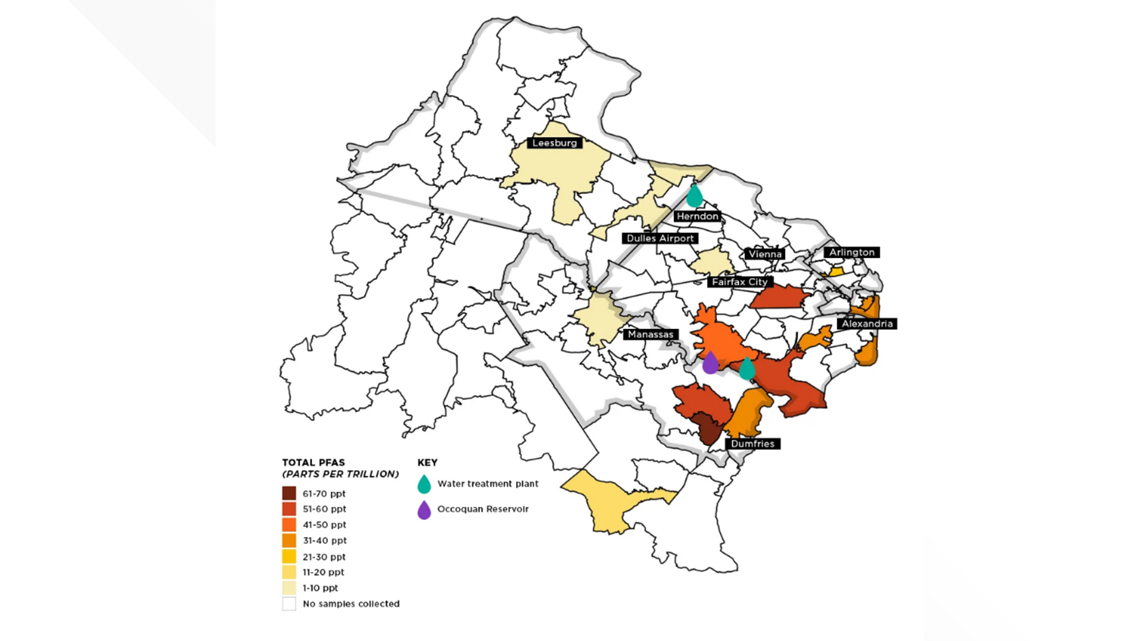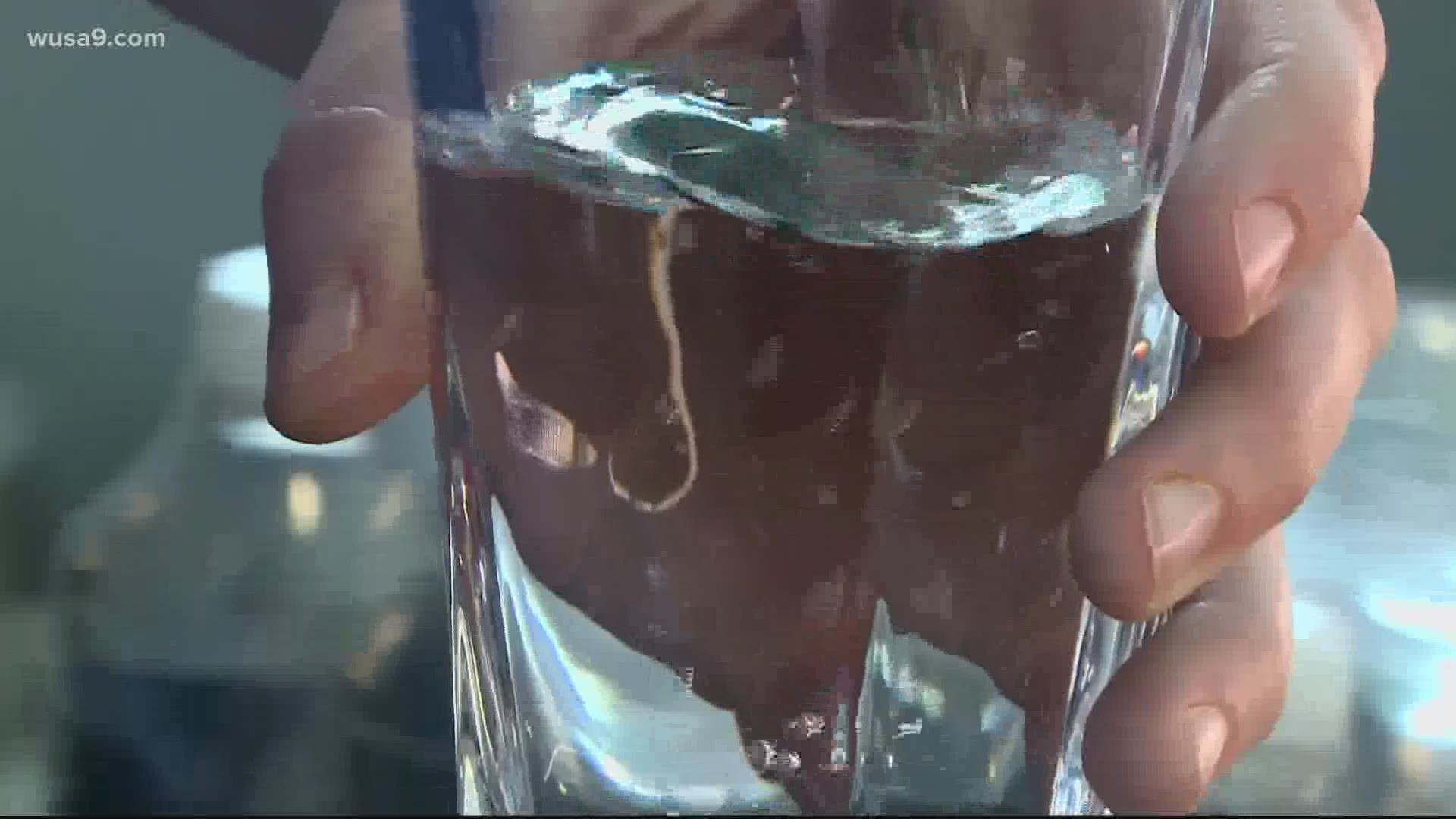FAIRFAX, Va. — A new report found so-called "forever chemicals" in Northern Virginia tap water at levels far higher than limits advocated by an environmental group.
Tests commissioned by the Environmental Working Group of 19 tap water samples found PFAS levels as high as 62 parts per trillion in a public park in Prince William County. The result is about three times higher than the EWG found in 2019 in D.C. and Prince George's County, and is among the highest in the U.S.
The Environmental Working Group said the samples were collected by its staff and volunteers and analyzed by an accredited lab using methods approved by the EPA. The 19 samples collected by EWG ranged from as low as 5.5 parts per trillion to as high as 62.4 parts per trillion.
There is no upper legal federal limit for PFAS, but the EPA recommendation is to keep them below 70 parts per trillion. The EWG is pushing for a limit of one part per trillion and the Natural Resources Defense Council recommends a limit of below seven parts per trillion. One part per trillion is about one drop in 20 Olympic-sized swimming pools.
Currently, the EPA and other state environmental agencies are not required to make their results public or report them to state drinking water agencies. And as of right now, the EPA has yet to establish a maximum contaminant level.
Sydney Evans, a science analyst, is calling on leaders to make changes before the problem spreads further.
“There is no monitoring, for the most part, required right now," Evans said. "There is no treatment required. That's the drinking water we have, we need to protect it. This is going to continue to be an increasing problem.”
The EPA said there is evidence PFAS (per- and polyfluoroalkyl substances) "can lead to adverse human health effects" including:
- low infant birth weights,
- effects on the immune system,
- cancer (for PFOA), and
- thyroid hormone disruption


The EWG report said it's not clear where the contamination is coming from. A lot of tap water in the D.C. region is drawn from the Potomac River, but Northern Virginia also uses the Occoquan River, which supplies water to about 40% of the 1.7 million customers of the Fairfax Water Authority (FWA).
WUSA9 reached out to FWA for a reaction
"No PFAS were detected in Fairfax Water’s sampling conducted as part of the EPA’s Unregulated Contaminant Monitoring Rule 3," FWA said in an email response. "We are not aware of any local agencies having testing results that were in exceedance of EPA’s health advisory levels for PFOA and PFOS."
According to FWA, the Virginia Department of Health plans to conduct a study on PFAS levels in the state's drinking water.
"We are awaiting further guidance from VDH on the matter," FWA said in its email. "We will take necessary actions to meet future state and federal regulations when they are established. Currently, there are no treatment processes available for drinking water utilities that would not significantly increase water rates for customers. Nor would such treatments produce a demonstrated health benefit."
Fairfax Water reiterated the importance of source water protection in order to keep tap water drinkable.
"Protecting drinking water sources and keeping PFAS away from water supplies is a priority," FWA said.


After EWG's 2019 report, the Washington Suburban Sanitary Commission resumed testing for PFAS at its two filtration plants.
"Only two compounds (Perfluorohexanoic acid and Perfluorooctanoic acid) were detected, at levels barely above the minimum reporting level of 1.8 parts per trillion - well below the EPA's health advisory level of 70 ppt," Washington Suburban Sanitary Commission said.
RELATED: WSSC Water will test for toxins after report of chemicals in Prince George's County tap water
According to the EPA, PFAS can be found in:
- Food packaged in PFAS-containing materials, processed with equipment that used PFAS, or grown in PFAS-contaminated soil or water.
- Commercial household products, including stain- and water-repellent fabrics, nonstick products (e.g., Teflon), polishes, waxes, paints, cleaning products, and fire-fighting foams (a major source of groundwater contamination at airports and military bases where firefighting training occurs).
- Workplace, including production facilities or industries (e.g., chrome plating, electronics manufacturing or oil recovery) that use PFAS.
- Drinking water, typically localized and associated with a specific facility (e.g., manufacturer, landfill, wastewater treatment plant, firefighter training facility).
- Living organisms, including fish, animals and humans, where PFAS have the ability to build up and persist over time.
The dangers of PFAS are the subject of the film Dark Waters, based on the true story of contamination in West Virginia that manufacturer DuPont was eventually found liable for.
Here a few ways to reduce exposure to PFAS:
- Support efforts to protect drinking water sources and keep PFAS out of water supplies.
- Cook with stainless steel, cast-iron, glass, or ceramics. Don’t use nonstick cookware.
- Throw out scratched or chipped nonstick cookware.
- Read ingredient lists and choose products without PTFE or perfluoro- or polyfluor-.
- Look for coats, hats, and boots labeled water-resistant. They’re less likely to have PFAS than waterproof products.
- Make popcorn on the stove or in an air popper instead of microwave bags.
- Steer clear of ordering food in grease-resistant wrappers or containers.
- Avoid carpets and upholstery treated to be stain or water-resistant; decline stain treatment.
- Ask manufacturers if their products contain PFAS. These chemicals are often not listed.

